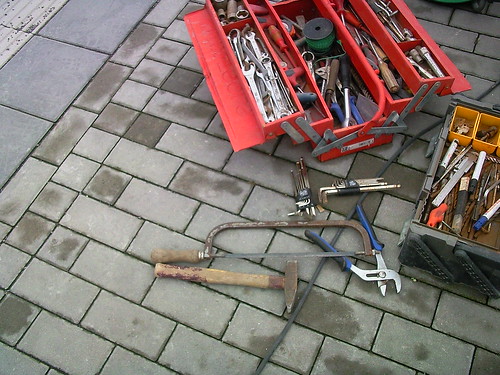 It is a common phrase in the world of physical therapy education: you need to have more tools in your toolbox. Frankly, the phrase drives me crazy.
It is a common phrase in the world of physical therapy education: you need to have more tools in your toolbox. Frankly, the phrase drives me crazy.
Clinicians learn to use a lot of tools. This isn't exclusive to physical therapy - far from it. Chiropractors, physicians, physical therapists - regardless of clinician, they all learn to utilize a broad range of tools in the care of various clinical conditions.
But what gets lost in the mix is the toolbox - the place you store all your tools and the process of reasoning used to select the correct tool. This becomes all the more readily apparent when discussing MDT (Mechanical Diagnosis And Therapy) with clinicians and students alike.
MDT is the toolbox - not the tools.
The educational process tends to over-emphasize treatment interventions - the "tools of the trade" if you will. I can guarantee that a screwdriver won't work for everything (trust me, I have tried). That being the case, you need to be able to select the correct tool for the clinical scenario and utilize it correctly. That requires a sound clinical reasoning process - a good toolbox.
I have interacted with countless clinicians and students over the years, and there is what I would consider a profound misconception of MDT that prevails. It starts at the entry level of education and builds momentum from there.
MDT may have been completely ignored in your entry level education. Even if it was presented, it was probably in the context of being a "tool" or "protocol" - a treatment novelty (albeit an evidence-based one) amongst other non-evidence-based (and perhaps even non-science-based) treatment novelties. There is always a perceived obligation to provide students with more tools, and MDT is often presented as such - just another tool.
I would almost guarantee that if it was a part of your entry level education, it almost certainly wasn't presented to you as a toolbox to hold all your other tools.
When you perceive MDT as a tool, it is no wonder that I hear clinician comments like .
"How could anyone ever think of treating ALL patients like that?"
"I am sure that MDT will be useful, but I have to figure out which patients I use IT on"
"What do you do when MDT doesn't work?".
Let's go ahead and set the record straight: MDT is NOT a tool. I repeat, it is NOT a tool. It is not a screwdriver in the toolbox of the physical therapist, the chiropractor, or the physician.
But it is a great toolbox. It provides you with a framework in which to store all of your tools. It keeps you organized in your thinking. It gives the clinician a sound clinical reasoning process to provide them with the means of selecting the appropriate tool, whatever it might be.
It is hard to imagine that with the evidence and scientific support currently available, MDT is still not consistently acknowledged as a toolbox. The misconceptions persist to this day.
Was MDT a part of your clinical education? If so, was it taught in the context of tools or toolbox?
Photo credits: erix!
 "Running Injuries: Etiology And Recovery- Based Treatment" (co-author Bridget Clark, PT) appears in the third edition and fourth editions of "Clinical Orthopaedic Rehabilitation: A Team Approach" by Charles Giangarra, MD and Robert C. Manske, PT.
"Running Injuries: Etiology And Recovery- Based Treatment" (co-author Bridget Clark, PT) appears in the third edition and fourth editions of "Clinical Orthopaedic Rehabilitation: A Team Approach" by Charles Giangarra, MD and Robert C. Manske, PT.
 Allan Besselink, PT, DPT, Ph.D., Dip.MDT has a unique voice in the world of sports, education, and health care. Read more about Allan here.
Allan Besselink, PT, DPT, Ph.D., Dip.MDT has a unique voice in the world of sports, education, and health care. Read more about Allan here.
 Top 5 finalist in three categories: "Best Overall Blog", "Best PT Blog" and "Best Advocacy Blog".
Top 5 finalist in three categories: "Best Overall Blog", "Best PT Blog" and "Best Advocacy Blog".